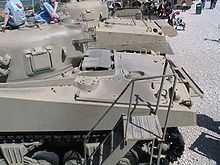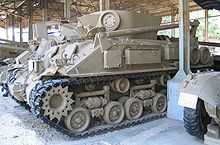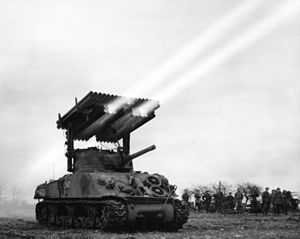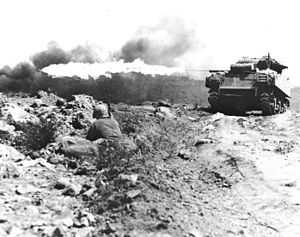M4 Sherman variants
The M4 Sherman tank was produced in several variants and it was also the basis for a number of related vehicles. In addition, Shermans have been modified by several nations from modernization upgrades to complete hull conversions for another task.
Overview

When the Sherman Tank was initially created, it was designed around US theory about how medium tanks, and full-track armored vehicles in general, should be utilized on the battlefield. In US doctrine, the medium tank's job was to assist infantry in the assault and provide a base of fire to fight from. Taking on enemy tanks were the job of purpose-built tank destroyers. The UK, which was a major user of the Sherman, differed in doctrine - tanks were expected to engage enemy tanks.
The wide array of special duties that a tank could be used for were just being explored by armies around the world in the early 1940s. Theories of what vehicles were supposed to be engaging enemy tanks changed as vehicles like the Shermans often found themselves up against enemy armor, and consequently some of the most important initial changes centered around upgunning the basic vehicle. Improving the vehicles mobility, protection, and creating specific variants for infantry support roles soon followed. Similar modification of the main armament would be done by the British who received a number of Shermans during the course of the war. Turning earlier variants of the Sherman into Armored Personnel Carriers or "Kangaroos" was also common, as was turning them into recovery vehicles.
More radical variants followed, first with experiments with flotation screens in preparation for the invasion of Europe by Allied forces in 1944, and later by the addition of rocket launching equipment mounted on the turret. Extensive work on creating mine clearance devices to be attached to Shermans or out of Shermans in some fashion was also conducted up until the end of the Second World War.
After the end of the Second World War, large numbers of surplus Shermans were supplied to other nations, but primarily to South America and the Middle East. Israel became the largest post-war user of Sherman tanks, conducting extensive modifications to keep them in front line service right up into the early 1970s as tanks, mobile artillery pieces, armored ambulances and more. Many saw action in the 1973 October War. Similar modifications and purchases of Israeli-modified Shermans were done in South America where they served on as the last fighting Shermans right up until 1989.
US variants


US M4 sub-types
- M4
- Continental radial engine; welded hull. 75mm short barrel cannon. Users: US, Britain, Poland, France.
- M4(105) - Upgraded with 105mm M4 Howitzer, designed for infantry support and assault, sacrificing anti-armour capability.
- M4(105) HVSS - M4(105) w/ HVSS.
- M4A1
- Continental radial engine; one-piece cast hull; 75mm short barrel cannon. Users: US, Britain, South Africa, Poland(M4A1(76)W), France (small numbers), China
- M4A1E4/M4A1(76)W - Upgraded with 76 mm M1 gun.
- M4A1E8/M4A1(76)W HVSS - Upgraded with widetrack Horizontal Volute Spring Suspension (HVSS), fitted with the 76 mm M1 gun.
- M4A1E9 - Late war remanufacturing, applique armor, new vision cupola and oval loader's hatch on the turret roof, spaced out VVSS suspension, extended end connectors on both sides of the tracks, but retaining the old 75 mm M3 gun. Users: Chile
- M4A2
- Diesel-powered with General Motors 6046 using powertrain from earlier M3A3/M3A5; first model manufactured with welded hull; 75mm short and long barrel cannon. Users: USSR, Britain, France, Poland, US. No US Army combat use except for DD conversions for the Omaha landings.
- M4A2E4 - Upgraded with Torsion Bar suspension; never put into production.
- M4A2E8/M4A2(76)W HVSS - Upgraded with widetrack Horizontal Volute Spring Suspension (HVSS), fitted with the 76mm M1 gun.
- M4A3
- Ford GAA V-8 engine; welded hull; both 75mm and 76mm cannons used. Users: US, France (small numbers), Nicaragua (small numbers). The M4A3 was the preferred US Army vehicle.
- M4A3(75) - M4A3 with 75mm M3 gun.
- M4A3(105) - M4A3 with 105mm mortar cannon used for infantry support rather than anti-armour.
- M4A3E2 Assault Tank - postwar nickname "Jumbo" - extra armour (including 1 inch on front), vertical sided turret, but about 3-4 mph slower. Built with 75mm gun but frequently re-armed by the using units with 76mm guns. Grousers fitted to the tracks. Users: US, France (one vehicle)
- M4A3E4/M4A3(76)W - M4A3 with 76mm M1 gun.
- M4A3E8/M4A3(76)W HVSS (Easy Eight) - Upgraded with widetrack Horizontal Volute Spring Suspension (HVSS), fitted with the 76mm High Velocity cannon.
- M4A3E9/M4A3(105) HVSS - Upgraded with widetrack Horizontal Volute Spring Suspension (HVSS)
- M4A4
- Chrysler A57 engine; welded, lengthened hull; 75-mm gun only as-built. Users: Britain, France, China, Lebanon (Firefly), Nicaragua (small numbers).
- Sherman Firefly/Sherman Vc - About 2,000 were re-armed by the British with their 17-pounder (76.2 mm) guns as the Sherman Firefly. (It should be noted that the Firefly variant wasn't exclusive to M4A4/Sherman V subtype, as 17-pounder gun was mounted on more Sherman subtypes.)
- M4A5
- No US vehicle was built with this designation; the number was meant to signify Canadian production. Known as the Ram tank, it was actually a modified version of the M3 medium tank that was built in Canada.
- M4A6
- Caterpillar D200A turbocharged, air-cooled radial multi-fuel engine adapted from Wright G200; composite cast/welded hull lengthened similarly to the M4A4; 75mm gun only. Only a 75 of this variant were built and none were used in combat.[1]
US Sherman-based vehicles
Variants without the M4 designation but built on the M4 medium chassis (While some began on the M3 chassis, some subvariants were switched to the M4 chassis during production. These are the models listed here):
- 105mm Howitzer Motor Carriage M7B1 - self-propelled 105 mm Howitzer Motor Carriage (HMC) based on the M4A3 Sherman chassis.
- 155mm Gun Motor Carriage M12 - self-propelled 155 mm Gun Motor Carriage (GMC).
- Cargo Carrier M30 - Cargo Carrier (an M12 with crew and ammunition space in lieu of the gun).
- 155mm Gun Motor Carriage M40 - self-propelled 155 mm GMC (Either M1A1 or M2 gun) based on the M4A3 (HVSS) chassis.
- 8in Howitzer Motor Carriage M43 - self-propelled 8 inch HMC (standardized post-World War II).
- 3in Gun Motor Carriage M10 - tank destroyer based on the M4A2 Sherman chassis.
- 3in Gun Motor Carriage M10A1 - Same as the M10, but based on the M4A3 Sherman chassis.
- 90mm Gun Motor Carriage M36 - tank destroyer based on M10A1 hull (M4A3 chassis); standard model.
- 90mm Gun Motor Carriage M36B1 - tank destroyer based on M4A3 Sherman hull and chassis; expedient model.
- 90mm Gun Motor Carriage M36B2 - tank destroyer based on M10 hull (M4A2 chassis, diesel); expedient model.


- Tank Recovery Vehicle M32
- based on M4 chassis with turret replaced by fixed superstructure, 60.000 lb winch and an 18 feet long pivoting A-frame jib installed. An 81mm Mortar was also added into the hull, primarily for screening purposes.
- Tank Recovery Vehicle M32B1 - M32s converted from M4A1s.
- Tank Recovery Vehicle M32A1B1 - M32B1's with HVSS, later removing the 81mm Mortar and incorporating crane improvements.
- Tank Recovery Vehicle M32B2 - M32's converted from M4A2's.
- Tank Recovery Vehicle M32B3 - M32's converted from M4A3's.
- Tank Recovery Vehicle M32A1B3 - M32B3's brought to the same standard as the M32A1B1.
- Tank Recovery Vehicle M32B4 - M32's converted from M4A4's.
- Tank Recovery Vehicle M32B1 - M32s converted from M4A1s.
- M74 Tank Recovery Vehicle
- Upgrade of the M32 to provide the same capability with regards to heavier post-war tanks, converted from M4A3 HVSS tanks. In appearance the M74 is very similar to the M32, fitted with an A-Frame crane, a main towing winch, an auxiliary winch, and a manual utility winch. The M74 also has a front mounted spade that can be used as a support or as a dozer blade.
- M74B1 - Same as the M74, but converted from M32B3s.
- M34 Prime Mover - M32B1 TRV converted to the artillery tractor role. 24 vehicles were converted by Chester Tank Depot in 1944.
US Special Attachment variants

Rocket-firing, flame-thrower, mine-clearing, amphibious, engineer; mostly experimental (indicated by T instead of M)
- Sherman DD (Duplex drive) - Amphibious M4.
- M4 Mobile Assault Bridge.
- M4 Dozer - fitted with M1 (side arm) or M2 (hydraulic mount) dozer blade.
- T15/E1/E2 - Series of mine resistant Shermans based on the T14 kit. Cancelled at war's end.
- Mine Exploders / Mine Excavators - fitted with various mine exploding devices including plungers, rollers, mortars. Most of those remained experimental vehicles.
- Mine Exploder T1E1 Roller (Earthworm) - Discs made from armor plate.
- Mine Exploder T1E2 Roller - Two forward units with 7 discs only. Experimental.
- Mine Exploder T1E3/M1 Roller (Aunt Jemima) - Two forward units with 5 10' discs. Most widely used T1 variant, adopted as the M1.
- Mine Exploder T1E4 Roller - 16 discs
- Mine Exploder T1E5 Roller - T1E3/M1 w/ smaller wheels. Experimental.
- Mine Exploder T1E6 Roller - T1E3/M1 w/ serrated edged discs. Experimental
- Mine Exploder T2 Flail - British Sherman Crab I mine flail.
- Mine Exploder T3 Flail - Based on British Scorpion flail. Development stopped in 1943.
- Mine Exploder T3E1 Flail - T3 w/ longer arms and sand filled rotor. Cancelled.
- Mine Exploder T3E2 Flail - E1 variant, rotor replaced with steel drum of larger diameter. Development terminated at war's end.
- Mine Exploder T4 - British Crab II mine flail.
- Mine Exploder T7 - Frame with small rollers with two discs each. Abandoned.
- Mine Exploder T8 (Johnny Walker) - Steel plungers on a pivot frame designed to pound on the ground. Vehicle steering was adversely affected.
- Mine Exploder T9 - 6' Roller. Difficult to maneuver.
- Mine Exploder T9E1 - Lightened version, but proved unsatisfactory because it failed to explode all mines.
- Mine Exploder T10 - Remote control unit designed to be controlled by the following tank. Cancelled.
- Mine Exploder T11 - 6 forward firing mortars to set off mines. Experimental.
- Mine Exploder T12 - 23 forward firing mortars. Apparently effective, but cancelled.
- Mine Exploder T14 - Direct modification to a Sherman tank, upgraded belly armor and reinforced tracks. Cancelled.
- Mine Excavator T4 - Plough device. Developed during 1942, but abandoned.
- Mine Excavator T5/E1/E2 - T4 variant w/ v-shaped plough. E1/E2 was a further improvement.
- Mine Excavator T5E3 - T5E1/E2 rigged to the hydraulic lift mechanism from the M1 dozer kit to control depth.
- Mine Excavator T6 - Based on the v-shape/T5, unable to control depth.
- Mine Excavator T2/E1/E2 - Based on the T4/T5's, but rigged to the hydraulic lift mechanism from the M1 dozer kit to control depth.


- Rocket Launchers:
- Rocket Launcher T34 (Calliope) - armed with 60 4-6" rocket tubes mounted above the turret. Saw limited combat in 1944-1945.
- Rocket Launcher T34E1 - T34 with 14 tubes in the 2 bottom units.
- Rocket Launcher T34E2 - T34 modified to accept 7.2" rockets.
- Rocket Launcher T39 - Enclosed box mount with doors, with 20 7.2" rockets.
- Rocket Launcher T40/M17 WhizBang - armed with 20 7.2" rockets. Saw limited combat in 1944-45. A short variant of the T40 was also developed, but saw little usage.
- Rocket Launcher T72 - T34 short tube variant. Never used.
- Rocket Launcher T73 - Similar to the T40, but with only 10 tubes. Never used.
- Rocket Launcher T76 - M4A1 w/ 7.2" rocket launcher in place of main gun. Never used.
- Rocket Launcher T105 - M4A1 w/ rocket case instead of main gun. Never used.
- Multiple Rocket Launcher T99 - 2 box mounts with 22 4.5" rockets, mounted on the turret. Never used.
- Flame Throwers:
- M4A3R3 Flame thrower - Also known as "Zippo tanks" or more commonly Flame tanks.
- M4 Sherman Crocodile - M4 tank modified with the flamethower and fuel trailer from a Churchill Crocodile. Four built and issued to 739th Tank Battalion which was attached to the 29th Division for Operation Grenade in February 1945, where they cleared the Old Citadel in the town of Julich. After the Rhine had been crossed, they were attached to 2nd Armoured division but saw little further use.[2]
Lend-Lease service
The M4 Sherman series were widely distributed to allied armies under the Lend-Lease program. Variants served in all theaters, and were the basis of a number of conversions for various uses including armored personnel carriers and specialized engineering vehicles.
Post-war variants
The M4 Sherman pattern enjoyed a lengthy post-war service all over the world. They were used well into the 1960s and 1970s by some nations, mainly in Africa and Latin America. In some cases the vehicles were converted for use in a variety of other roles from mobile artillery to ambulances. Conversions were also made for use in civilian industry.
Notes and references
- ↑ R. P. Hunnicutt, Sherman - A History of the American Medium Tank, pg. 167-169
- ↑ "Sherman Crocodile" Steve Zaloga Military Modelling, Volume 32, No.15, 2002
External links
| Wikimedia Commons has media related to M4 Sherman. |